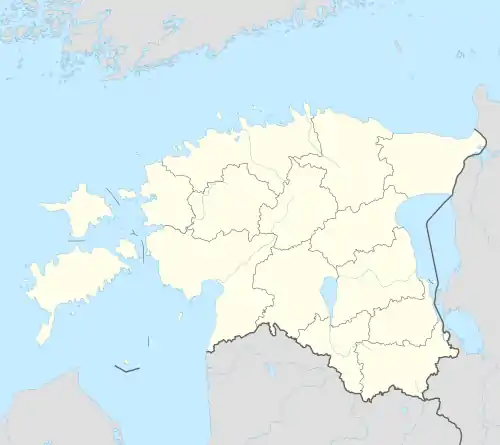Jõhvi
Jõhvi is a town in north-eastern Estonia, and the capital of Ida-Viru County. The town is also an administrative centre of Jõhvi Parish. It is situated 50 km from the Russian border.
Jõhvi | |
|---|---|
 | |
 Jõhvi Location in Estonia | |
| Coordinates: 59°21′27″N 27°25′37″E | |
| Country | Estonia |
| County | Ida-Viru County |
| Municipality | Jõhvi Parish |
| City status | 1938 |
| Area | |
| • Total | 7.62 km2 (2.94 sq mi) |
| Population (2021)[1] | |
| • Total | 10,130 |
| • Rank | 13th |
| • Density | 1,300/km2 (3,400/sq mi) |
| Ethnicity | |
| • Estonians | 34.5% |
| • Russians | 55.7% |
| • other | 9.6% |
| Time zone | UTC+2 (EET) |
| • Summer (DST) | UTC+3 (EEST) |
| Postal code | 41501 to 41599 |
| Area code(s) | (+372) 33 |
Ethnic Estonians are a minority in Jõhvi, as about 55% of the town's population are ethnic Russians.
History
Jõhvi was first mentioned as a village in 1241 in Liber Census Daniae when it was ruled by Denmark. Historical names of Jõhvi were Gewi and Jewi. In the 13th century a church was built here and Jõhvi became the centre of the local church parish.
On 1 May 1938 Konstantin Päts renamed the Jõhvi borough a town along with nearly all Estonian boroughs. Up to 1991, Jõhvi was a district of Kohtla-Järve. In 2005 the town of Jõhvi was united with the parish of Jõhvi.
Climate
| Climate data for Jõhvi (normals 1991–2020, extremes 1926–present) | |||||||||||||
|---|---|---|---|---|---|---|---|---|---|---|---|---|---|
| Month | Jan | Feb | Mar | Apr | May | Jun | Jul | Aug | Sep | Oct | Nov | Dec | Year |
| Record high °C (°F) | 8.9 (48.0) |
8.1 (46.6) |
16.8 (62.2) |
26.0 (78.8) |
32.1 (89.8) |
33.1 (91.6) |
33.7 (92.7) |
34.6 (94.3) |
28.1 (82.6) |
19.7 (67.5) |
13.6 (56.5) |
10.9 (51.6) |
34.6 (94.3) |
| Average high °C (°F) | −2.3 (27.9) |
−2.4 (27.7) |
1.9 (35.4) |
9.5 (49.1) |
15.8 (60.4) |
19.6 (67.3) |
22.4 (72.3) |
21.0 (69.8) |
15.7 (60.3) |
8.5 (47.3) |
2.7 (36.9) |
−0.5 (31.1) |
9.3 (48.7) |
| Daily mean °C (°F) | −4.6 (23.7) |
−5.2 (22.6) |
−1.7 (28.9) |
4.5 (40.1) |
10.3 (50.5) |
14.6 (58.3) |
17.4 (63.3) |
15.9 (60.6) |
11.2 (52.2) |
5.5 (41.9) |
0.6 (33.1) |
−2.5 (27.5) |
5.5 (41.9) |
| Average low °C (°F) | −7.5 (18.5) |
−8.5 (16.7) |
−5.5 (22.1) |
−0.1 (31.8) |
4.3 (39.7) |
9.1 (48.4) |
11.9 (53.4) |
10.9 (51.6) |
7.0 (44.6) |
2.4 (36.3) |
−1.7 (28.9) |
−5 (23) |
1.4 (34.5) |
| Record low °C (°F) | −34.5 (−30.1) |
−36 (−33) |
−28.4 (−19.1) |
−18 (0) |
−6.5 (20.3) |
−2.5 (27.5) |
1.7 (35.1) |
−0.6 (30.9) |
−4.2 (24.4) |
−15.7 (3.7) |
−25.9 (−14.6) |
−41 (−42) |
−41 (−42) |
| Average precipitation mm (inches) | 45 (1.8) |
34 (1.3) |
36 (1.4) |
34 (1.3) |
50 (2.0) |
84 (3.3) |
77 (3.0) |
93 (3.7) |
67 (2.6) |
84 (3.3) |
64 (2.5) |
49 (1.9) |
717 (28.2) |
| Average precipitation days (≥ 1.0 mm) | 12 | 9 | 9 | 8 | 7 | 10 | 11 | 12 | 13 | 14 | 14 | 14 | 132 |
| Average relative humidity (%) | 90 | 88 | 80 | 72 | 68 | 73 | 76 | 80 | 84 | 87 | 90 | 91 | 82 |
| Source: Estonian Weather Service (precipitation days, 1971–2000)[2][3][4][5][6] | |||||||||||||
Gallery
 Jõhvi church
Jõhvi church Central square
Central square Jõhvi Gymnasium
Jõhvi Gymnasium Jõhvi promenade
Jõhvi promenade Jõhvi Concert Hall
Jõhvi Concert Hall Jõhvi Central Library
Jõhvi Central Library Jõhvi at night
Jõhvi at night Monument in memoriam of Kaljo Kiisk
Monument in memoriam of Kaljo Kiisk
References
- "Population by sex, age group and place of residence after the 2017 administrative reform, 1 January". Statistics Estonia. Retrieved 2021-12-26.
- "Climate normals-Temperature". Estonian Weather Service. Retrieved 14 February 2021.
- "Climate normals-Precipitation". Estonian Weather Service. Retrieved 14 February 2021.
- "Climate normals-Humidity". Estonian Weather Service. Retrieved 14 February 2021.
- "Kliimanormid-Sademed, õhuniiskus" (in Estonian). Estonian Weather Service. Archived from the original on 22 February 2012. Retrieved 14 February 2021.
- "Rekordid" (in Estonian). Estonian Weather Service. Retrieved 19 March 2021.
External links
| Wikivoyage has a travel guide for Jõhvi. |
| Wikimedia Commons has media related to Jõhvi. |
This article is issued from Wikipedia. The text is licensed under Creative Commons - Attribution - Sharealike. Additional terms may apply for the media files.
